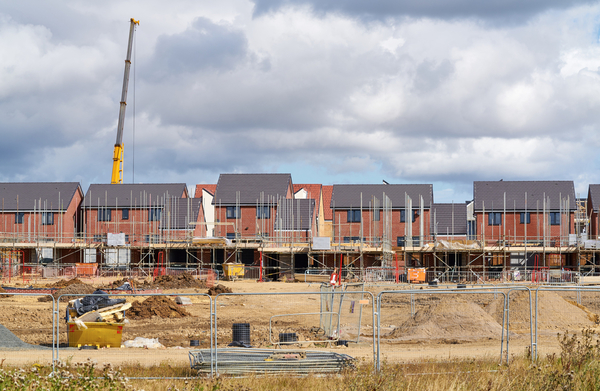You are viewing 1 of your 1 free articles
 Jules Birch
Jules BirchThe Letwin Review might just be worth waiting for
Jules Birch scrutinises today’s update on the work of the Letwin Review and finds reasons for optimism
So, with unintentional irony, the inquiry into why it takes so long to get new homes built is itself taking longer than expected.
For all the advance speculation and ministerial statements in the last few days, the Letwin Review of build-out rates was not published alongside today’s Spring Statement.
Instead the former Conservative cabinet minister published a four-page letter offering housing secretary Sajid Javid an interim update on the work of the inquiry, focusing on what is happening on large sites operated by large house builders.
A ‘draft analysis’ will follow by the end of June offering a description of the problem and its causes, but final recommendations will only be made in time for the Budget in November.
In truth, expectations that Mr Letwin would be able to offer instant solutions within a few months were always likely to be dashed – not that this stopped ministers from pre-empting the review with warnings to house builders to ‘do their duty’ in the planning announcements last week.
“Expectations that Mr Letwin would be able to offer instant solutions within a few months were always likely to be dashed.”
Perhaps significantly, the draft update has only one mention of the supposedly crucial issue of ‘land banks’, the nefarious practice by which house builders allegedly hoard land with planning permission until they can make the most money.
However, Letwin rejects most of their usual excuses too – everything from shortages of labour, materials and capital, to problems with transport infrastructure, utility connections and constrained logistics on site.
He argues instead that the “fundamental driver of build-out rates once detailed planning permission is granted for large sites appears to be the ‘absorption rate’”.
This is “the rate at which newly constructed homes can be sold into (or are believed to be sold successfully into) the local market without materially disturbing the market price.”
That may seem self-evident – large developers will only build homes as quickly as they can sell them, and they will want to do it at a premium to local house prices to generate the profit margins they have promised the City – but Mr Letwin’s focus is significant for more than just market housing.
His draft update argues that the absorption rate appears to be determined by the types of home being constructed and price of the new homes being built: “The principal reason why house builders are in a position to exercise control over these key drivers of sales rates appears to be that there are limited opportunities for rivals to enter large sites and compete for customers by offering different types of homes at different price points and with different tenures.”
“The obvious implication of this is that more homes would be built more quickly if development was not so reliant on the sales market.”
Variations in the size and style of what gets built can lead to additional absorption and a higher rate of build-out, he says, and within this “differences of tenure are critical”.
The inquiry team has seen “ample evidence” that the rate of completion of affordable and social rented homes is constrained by the requirement for cross-subsidy from sales of open market housing.
If absorption rates are limited by prices for the new homes being close to those in the local second-hand market then limits on cross-subsidy will in turn limit the rate at which house builders will build out affordable and social homes: “If freed from these supply constraints, the demand for ‘affordable’ homes (including shared ownership) and ‘social rented’ accommodation on large sites would undoubtedly be consistent with a faster rate of build out.”
With the same point applying to new homes for private rent, the obvious implication of this is that more homes would be built more quickly if development was not so reliant on the sales market.
That is an important conclusion, even if some think there are more factors to consider – for example, absorption rates may vary in very different markets around the country and affordable housing development may sometimes support for-sale delivery, rather than the other way around.
Mr Letwin sets himself further questions to answer about the effect on absorption rates of large sites being packaged in different ways, with other types of house builder and other tenures, of reducing reliance on large sites for local delivery, and the impact of changing the absorption rate on the house builder business model.
He says he will investigate other reasons for delays and look at what effect faster build-out rates would have on developer land banks.
The inquiry team will continue to visit large sites, hold more meetings with stakeholders and look at more data.
But, perhaps significantly, it will also go to Germany and the Netherlands to look at how build-out rates are affected “by the use of public or publicly led mechanisms for increasing the variety of what is offered on large sites”.
That would appear to go some way beyond the market-focused terms of reference given to the review by Sajid Javid in November, and it implies a close look at the crucial role of land and the importance of public sector leadership in development.
The review may be taking its time, but the wait could yet be worth it.
Jules Birch, award-winning blogger
Spring Statement: key measures announced
- West Midlands Combined Authority agrees to provide 215,000 homes by 2030/31 facilitated by £100m grant from Land Remediation Fund
- London to receive additional affordable housing grant of £1.7bn to provide 26,000 more affordable homes in the capital
- More than double housing growth partnership with Lloyds Banking Group to £220m to provide finance for small builders]
- Talks underway with 44 councils which bid into the Housing Infrastructure Fund












